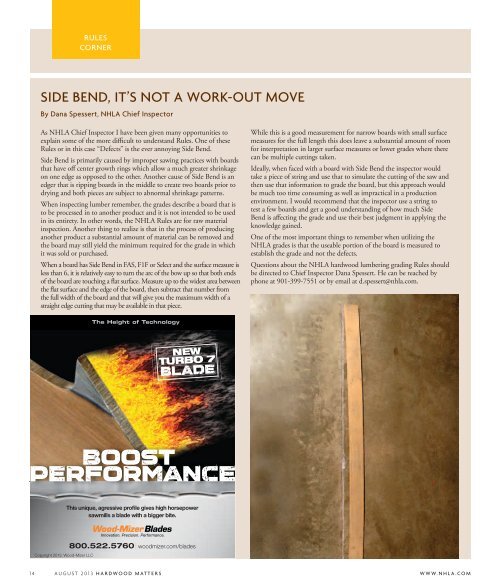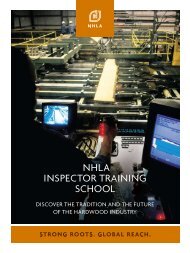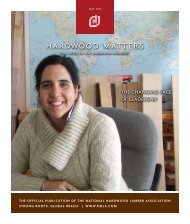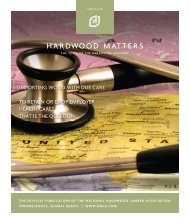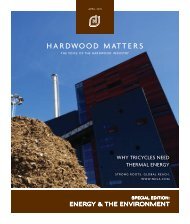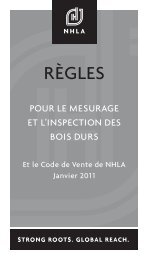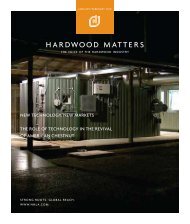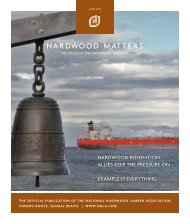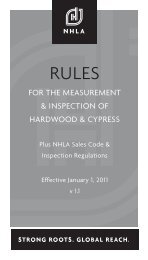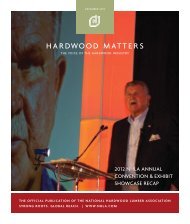hm - Aug13 - cover.indd - National Hardwood Lumber Association
hm - Aug13 - cover.indd - National Hardwood Lumber Association
hm - Aug13 - cover.indd - National Hardwood Lumber Association
- No tags were found...
Create successful ePaper yourself
Turn your PDF publications into a flip-book with our unique Google optimized e-Paper software.
RULES<br />
CORNER<br />
SIDE BEND, IT’S NOT A WORK-OUT MOVE<br />
By Dana Spessert, NHLA Chief Inspector<br />
As NHLA Chief Inspector I have been given many opportunities to<br />
explain some of the more difficult to understand Rules. One of these<br />
Rules or in this case “Defects” is the ever annoying Side Bend.<br />
Side Bend is primarily caused by improper sawing practices with boards<br />
that have off center growth rings which allow a much greater shrinkage<br />
on one edge as opposed to the other. Another cause of Side Bend is an<br />
edger that is ripping boards in the middle to create two boards prior to<br />
drying and both pieces are subject to abnormal shrinkage patterns.<br />
When inspecting lumber remember, the grades describe a board that is<br />
to be processed in to another product and it is not intended to be used<br />
in its entirety. In other words, the NHLA Rules are for raw material<br />
inspection. Another thing to realize is that in the process of producing<br />
another product a substantial amount of material can be removed and<br />
the board may still yield the minimum required for the grade in which<br />
it was sold or purchased.<br />
When a board has Side Bend in FAS, F1F or Select and the surface measure is<br />
less than 6, it is relatively easy to turn the arc of the bow up so that both ends<br />
of the board are touching a flat surface. Measure up to the widest area between<br />
the flat surface and the edge of the board, then subtract that number from<br />
the full width of the board and that will give you the maximum width of a<br />
straight edge cutting that may be available in that piece.<br />
While this is a good measurement for narrow boards with small surface<br />
measures for the full length this does leave a substantial amount of room<br />
for interpretation in larger surface measures or lower grades where there<br />
can be multiple cuttings taken.<br />
Ideally, when faced with a board with Side Bend the inspector would<br />
take a piece of string and use that to simulate the cutting of the saw and<br />
then use that information to grade the board, but this approach would<br />
be much too time consuming as well as impractical in a production<br />
environment. I would recommend that the inspector use a string to<br />
test a few boards and get a good understanding of how much Side<br />
Bend is affecting the grade and use their best judgment in applying the<br />
knowledge gained.<br />
One of the most important things to remember when utilizing the<br />
NHLA grades is that the useable portion of the board is measured to<br />
establish the grade and not the defects.<br />
Questions about the NHLA hardwood lumbering grading Rules should<br />
be directed to Chief Inspector Dana Spessert. He can be reached by<br />
phone at 901-399-7551 or by email at d.spessert@nhla.com.<br />
The Height of Technology<br />
NEW<br />
TURBO 7<br />
BLADE<br />
BOOST<br />
PERFORMANCE<br />
This unique, agressive profile gives high horsepower<br />
sawmills a blade with a bigger bite.<br />
Copyright 2013, Wood-Mizer LLC<br />
800.522.5760 woodmizer.com/blades<br />
14 AUGUST 2013 HARDWOOD MATTERS WWW.NHLA.COM


